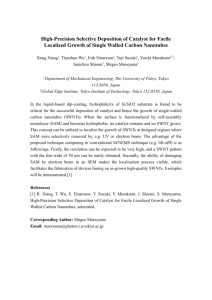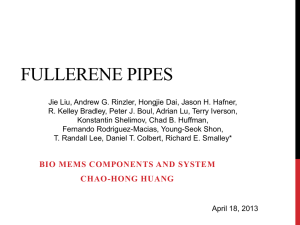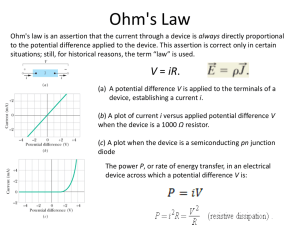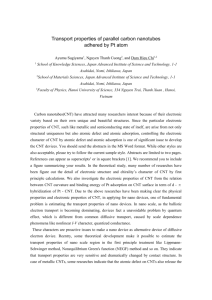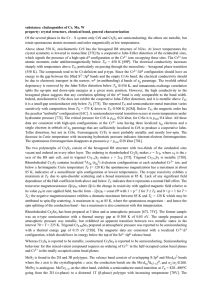A Selective Electrochemical Approach to Carbon Nanotube Field
advertisement
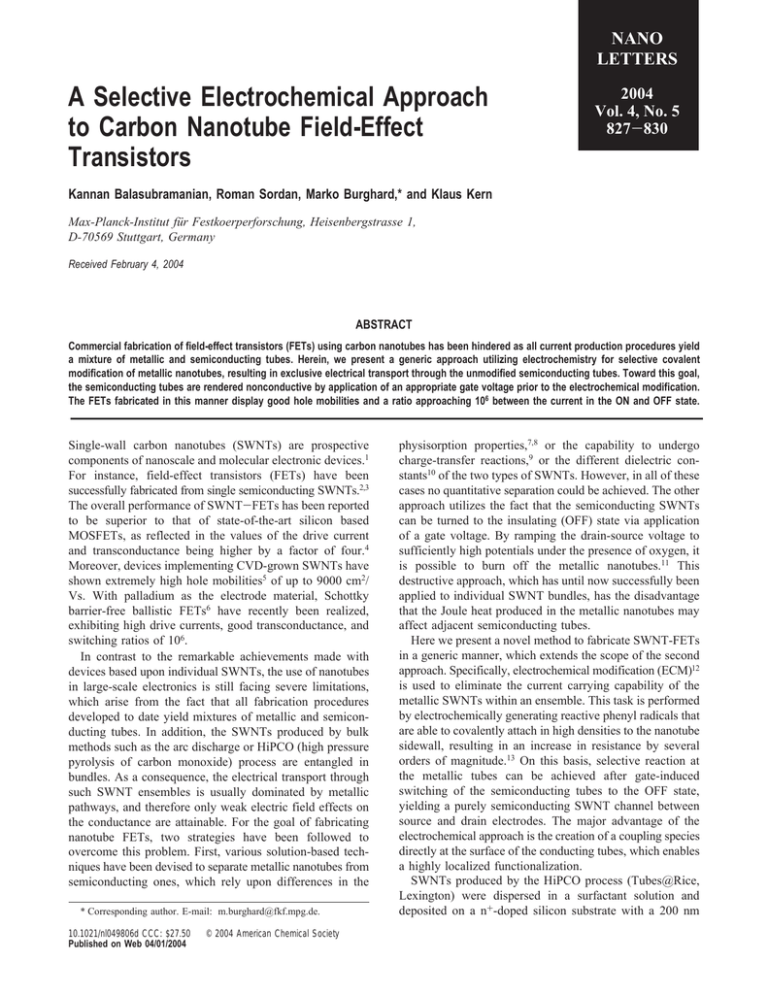
NANO LETTERS A Selective Electrochemical Approach to Carbon Nanotube Field-Effect Transistors 2004 Vol. 4, No. 5 827-830 Kannan Balasubramanian, Roman Sordan, Marko Burghard,* and Klaus Kern Max-Planck-Institut für Festkoerperforschung, Heisenbergstrasse 1, D-70569 Stuttgart, Germany Received February 4, 2004 ABSTRACT Commercial fabrication of field-effect transistors (FETs) using carbon nanotubes has been hindered as all current production procedures yield a mixture of metallic and semiconducting tubes. Herein, we present a generic approach utilizing electrochemistry for selective covalent modification of metallic nanotubes, resulting in exclusive electrical transport through the unmodified semiconducting tubes. Toward this goal, the semiconducting tubes are rendered nonconductive by application of an appropriate gate voltage prior to the electrochemical modification. The FETs fabricated in this manner display good hole mobilities and a ratio approaching 106 between the current in the ON and OFF state. Single-wall carbon nanotubes (SWNTs) are prospective components of nanoscale and molecular electronic devices.1 For instance, field-effect transistors (FETs) have been successfully fabricated from single semiconducting SWNTs.2,3 The overall performance of SWNT-FETs has been reported to be superior to that of state-of-the-art silicon based MOSFETs, as reflected in the values of the drive current and transconductance being higher by a factor of four.4 Moreover, devices implementing CVD-grown SWNTs have shown extremely high hole mobilities5 of up to 9000 cm2/ Vs. With palladium as the electrode material, Schottky barrier-free ballistic FETs6 have recently been realized, exhibiting high drive currents, good transconductance, and switching ratios of 106. In contrast to the remarkable achievements made with devices based upon individual SWNTs, the use of nanotubes in large-scale electronics is still facing severe limitations, which arise from the fact that all fabrication procedures developed to date yield mixtures of metallic and semiconducting tubes. In addition, the SWNTs produced by bulk methods such as the arc discharge or HiPCO (high pressure pyrolysis of carbon monoxide) process are entangled in bundles. As a consequence, the electrical transport through such SWNT ensembles is usually dominated by metallic pathways, and therefore only weak electric field effects on the conductance are attainable. For the goal of fabricating nanotube FETs, two strategies have been followed to overcome this problem. First, various solution-based techniques have been devised to separate metallic nanotubes from semiconducting ones, which rely upon differences in the * Corresponding author. E-mail: m.burghard@fkf.mpg.de. 10.1021/nl049806d CCC: $27.50 Published on Web 04/01/2004 © 2004 American Chemical Society physisorption properties,7,8 or the capability to undergo charge-transfer reactions,9 or the different dielectric constants10 of the two types of SWNTs. However, in all of these cases no quantitative separation could be achieved. The other approach utilizes the fact that the semiconducting SWNTs can be turned to the insulating (OFF) state via application of a gate voltage. By ramping the drain-source voltage to sufficiently high potentials under the presence of oxygen, it is possible to burn off the metallic nanotubes.11 This destructive approach, which has until now successfully been applied to individual SWNT bundles, has the disadvantage that the Joule heat produced in the metallic nanotubes may affect adjacent semiconducting tubes. Here we present a novel method to fabricate SWNT-FETs in a generic manner, which extends the scope of the second approach. Specifically, electrochemical modification (ECM)12 is used to eliminate the current carrying capability of the metallic SWNTs within an ensemble. This task is performed by electrochemically generating reactive phenyl radicals that are able to covalently attach in high densities to the nanotube sidewall, resulting in an increase in resistance by several orders of magnitude.13 On this basis, selective reaction at the metallic tubes can be achieved after gate-induced switching of the semiconducting tubes to the OFF state, yielding a purely semiconducting SWNT channel between source and drain electrodes. The major advantage of the electrochemical approach is the creation of a coupling species directly at the surface of the conducting tubes, which enables a highly localized functionalization. SWNTs produced by the HiPCO process (Tubes@Rice, Lexington) were dispersed in a surfactant solution and deposited on a n+-doped silicon substrate with a 200 nm Figure 1. (a) AFM phase image of a typical sample used in the experiments. The image shows two electrodes 10 µm wide and separated by ∼1.4 µm contacted with a number of SWNT bundles. (b) Gate dependence of conductance for a pure metallic SWNT bundle (dotted line) and for a purely semiconducting SWNT (solid line), measured at room temperature. The gate voltage scan was started at the point marked with the solid circle and stopped at the point marked with the solid square. A drain source voltage (Vds) of 1 mV was used for measuring the conductance of the metallic SWNT and 100 mV for the semiconducting SWNT. thick layer of thermally grown silicon dioxide, followed by deposition of 15 nm thick AuPd electrodes with ∼1.4 µm separation on top of the tubes through electron beam lithography. An atomic force microscope (AFM) image of one of the investigated samples is displayed in Figure 1a. The density of tubes was chosen such that between 1 and 10 individual tubes or thin bundles connected the two electrodes. The samples can be classified into three categories according to their electrical transport properties. In the first type, almost no gate dependence of conductance was observed (see Figure 1b, dotted curve), indicating the presence of exclusively metallic tubes, while in a second set of samples a strong gate dependence of conductance of at least 4 orders of magnitude was detected (see Figure 1b, solid curve), representative of transport through purely semiconducting tubes. A third set of samples displayed a weak gate dependence of conductance due to the presence of a mixture of both metallic and semiconducting tubes in the ensemble. Most of the measurements have been carried out under ambient conditions and hence display a strong hysteresis, which has been attributed to oxygen-related charge traps either in the SiO2 dielectric5 or very close to the nanotube,14,15 or to the presence of SiO2 surface-bound water 828 molecules.16 To selectively modify the metallic tubes by ECM, advantage has been taken of the hysteresis in the gate dependence in the following manner. After sweeping the gate potential to a positive value (g +20 V) and returning to zero, devices comprising semiconducting SWNTs were found to remain in the conducting or ON state. Similarly, the devices could be switched to the OFF state by sweeping the gate voltage to a negative value (e -20V) and going back to zero. The stability of the ON or OFF state was found to be of the order of 10 to 15 min, sufficient to perform ECM with the semiconducting tubes in the OFF state without the need for in-situ gate control. To optimize the parameters of the ECM (for example, the concentration of the diazonium salt, the magnitude and duration of the applied potential) with respect to maximal preservation of the semiconducting nanotubes, control studies were initially carried out with pure semiconducting and pure metallic tubes after gate tuning. It is noteworthy that in order to obtain reproducible results, the samples were heated at 100 °C for 2 h immediately after ECM, to ensure removal of physisorbed solvent molecules. The application of -280 mV vs platinum for 30 s in a 10 mM 4-nitrobenzene diazonium salt solution in N,N-dimethylformamide (DMF), with 0.1 M lithium perchlorate as background electrolyte was found to cause only minor changes in the conductance of an individual semiconducting nanotube in the OFF state, as demonstrated by Figure 2a. Here the black curve is the initial gate dependence of conductance, while the red curve corresponds to the gate dependence after ECM in the OFF state. On the contrary, after subjecting the same semiconducting SWNT in the ON state to ECM (blue line in Figure 2a), the conductance reduced by four orders of magnitude for all gate voltages. To test whether the metallic SWNTs are indeed modified under the OFF state conditions of the semiconducting tubes, the same parameters were applied to a purely metallic SWNT bundle. In general, the modified metallic tubes showed a strong increase in resistance, as exemplified in Figure 2b where the conductance is seen to drop down by four orders of magnitude. The same methodology was then applied to ensembles of SWNTs containing a mixture of both metallic and semiconducting SWNTs. For this purpose a single contacted bundle was taken. This bundle displayed a weak gate dependence of conductance, as apparent from Figure 3 (black curve). After ECM in the OFF state, the bundle thickness was found to be slightly increased, which results from the formation of a molecular coating due to polymerization of the electrochemically generated phenyl radicals at the SWNT/electrolyte interface.12 Most strikingly, the gate dependence of conductance of the modified bundle (shown by the red line in Figure 3) displays a significant increase in the ON to OFF ratio from 3 before modification to ∼106 afterward. The shape of the curve after ECM, as well as the magnitude of the ON current, are comparable to those of the individual semiconducting SWNT shown in Figure 2b, indicating that the contribution of the metallic SWNTs to the transport has been completely suppressed and the device now acts as a purely semiconducting FET. Nano Lett., Vol. 4, No. 5, 2004 Figure 3. Creation of an FET through selective ECM: Roomtemperature gate dependence curves of the sample before ECM (black curve) showing a weak gate dependence (ON/OFF ratio) of 3, indicating the presence of both metallic and semiconducting SWNTs in the bundle. The red curve is obtained after OFF state ECM and the device now exhibits a switching ratio of 8 × 105. Vds was 10 mV before ECM and 50 mV after ECM. Figure 2. Room-temperature gate dependence curves of (a) a pure semiconducting SWNT: initial (black line), after OFF state ECM (red line) and after ON state ECM (blue line); (b) a metallic SWNT bundle: initial (black) and after OFF state ECM (red). The curves signify that the semiconducting SWNTs are unaffected when ECM is performed after switching the device to the OFF state while the metallic SWNTs are modifiable under the same conditions. The parameters of the ECM were: -280 mV vs Pt for 30 s in 10 mM nitrobenzenediazonium tetrafluoroborate. Vds was 100 mV in (a) and 1 mV before ECM and 100 mV after ECM in (b). As it has recently been reported that aromatic diazonium salts in aqueous solutions react selectively with metallic tubes under certain conditions,17 control experiments have been performed by exposing individual metallic and semiconducting SWNTs to the diazonium salt separately in DMF and in water for up to 15 h without applying a potential. This was followed by heating the sample to 100 °C for 2 h, again to remove physisorbed solvent molecules. Under these conditions, no changes in conductance could be observed for both types of tubes. Although the present FETs likely contain more than one electrically active semiconducting tube, it is instructive to compare their device characteristics with those of singlenanotube FETs. While the former exhibit a room-temperature transconductance of ∼10 S/cm, values of up to 23 S/cm18 are documented for the best single-tube FET until now. This difference can largely be attributed to the compact architecture of the latter devices, wherein a very thin gate oxide of ∼15 nm has been utilized. The switching ratio obtained in our devices is of the order of 106, similar to ratios obtained Nano Lett., Vol. 4, No. 5, 2004 in other devices.6,19 The hole mobility, determined by assuming the classical FET model,20 is found to be ∼1000 cm2/Vs at room temperature for the ECM-based FETs, whereas the best device fabricated5 using single nanotubes showed a mobility of 9000 cm2/Vs. The higher mobility in the latter case is suggestive of the superior structural quality of SWNTs grown from solid-supported catalyst particles via chemical vapor deposition (CVD). In conclusion, we have presented a generic fabrication route for SWNT-FETs which combines electrochemistry and gate-induced modulation of conductivity. It was demonstrated that the modification of semiconducting tubes can be enabled or blocked by varying the history of the gate potential scans before performing electrochemistry. In this manner, the conduction through the metallic nanotubes in a SWNT ensemble can selectively be eliminated, resulting in high-performance FETs. In particular, the ECM-based method appears promising to improve the performance of existing FETs consisting of SWNT networks, which display poor switching ratios due to the coexistence of metallic and semiconducting tubes.21,22 An important future goal is to eliminate the hysteresis as a serious parasitic effect. One possibility to achieve this may be annealing of the samples in vacuum, followed by covering them with a capping layer.23,24 References (1) Saito, R.; Dresselhaus, G.; Dresselhaus, M. S. Physical Properties of Carbon Nanotubes; Imperial College Press: London, 1998. (2) Tans, S. J.; Verschueren, A. R. M.; Dekker, C. Nature 1998, 393, 49-52. (3) Martel, R.; Schmidt, T.; Shea, H. R.; Hertel, T.; Avouris, Ph. Appl. Phys. Lett. 1998, 73, 2447-2449. (4) Avouris, Ph.; Appenzeller, J.; Martel, R.; Wind, S. J. Proc. IEEE 2003, 91, 1772-1784. (5) Fuhrer, M. S.; Kim, B. M.; Dürkop, T.; Brintlinger, T. Nano Lett. 2002, 2, 755-759. (6) Javey, A.; Guo, J.; Wang, Q.; Lundstrom, M.; Dai, H. Nature 2003, 424, 654-657. (7) Chattopadhyay, D.; Galeska, I.; Papadimitrakopoulos, F. J. Am. Chem. Soc. 2003, 125, 3370-3375. 829 (8) Zheng, M.; Jagota, A.; Semke, E. D.; Diner, B. A.; McLean, R. S.; Lustig, S. R.; Richardson, R. E.; Tassi, N. G. Nature Materials 2003, 2, 338-342. (9) Chen, Z.; Du, X.; Du, M.-H.; Rancken, C. D.; Cheng, H.-P.; Rinzler, A. G. Nano Lett. 2003, 3, 1245-1249. (10) Krupke, R.; Hennrich, F.; Löhneysen, H. v.; Kappes, M. M. Science 2003, 301, 344-347. (11) Collins, P. G.; Arnold, M. S.; Avouris, Ph. Science 2001, 292, 706709. (12) Kooi, S. E.; Schlecht, U.; Burghard, M.; Kern, K. Angew. Chem., Int. Ed. 2002, 41, 1353-1355. (13) Balasubramanian, K.; Friedrich, M.; Jiang, C.; Fan, Y.; Mews, A.; Burghard, M.; Kern, K. AdV. Mater. 2003, 15, 1515-1518. (14) Radosavljević, M.; Freitag, M.; Thadani, K. V.; Johnson, A. T. Nano Lett. 2002, 2, 761-764. (15) Cui, J. B.; Sordan, R.; Burghard, M.; Kern, K. Appl. Phys. Lett. 2002, 81, 3260-3262. (16) Kim, W.; Javey, A.; Vermesh, O.; Wang, Q.; Li, Y.; Dai, H. Nano Lett. 2003, 3, 193-198. 830 (17) Strano, M. S.; Dyke, C. A.; Usrey, M. L.; Barone, P. W.; Allen, M. J.; Shan, H.; Kittrell, C.; Hauge, R. H.; Tour, J. M.; Smalley, R. E. Science 2003, 301, 1519-1522. (18) Wind, S. J.; Appenzeller, J.; Martel, R.; Derycke, V.; Avouris, Ph. Appl. Phys. Lett. 2002, 80, 3817-3819. (19) Martel, R.; Derycke, V.; Lavoie, C.; Appenzeller, J.; Chan, K. K.; Tersoff, J.; Avouris, Ph. Phys. ReV. Lett. 2001, 87, 256805. (20) Sze, S. M. Physics of Semiconductor DeVices; Wiley: New York, 1981. (21) Snow, E. S.; Novak, J. P.; Campbell, P. M.; Park, D. Appl. Phys. Lett. 2003, 82, 2145-2147. (22) Xiao, K.; Yunqi, L.; Hu, P.; Yu, G.; Wang, X.; Zhu, D. Appl. Phys. Lett. 2003, 83, 150-152. (23) Derycke, V.; Martel, R.; Appenzeller, J.; Avouris, Ph. Appl. Phys. Lett. 2002, 80, 2773-2775. (24) Derycke, V.; Martel, R.; Appenzeller, J.; Avouris, Ph. Nano Lett. 2001, 1, 453-456. NL049806D Nano Lett., Vol. 4, No. 5, 2004



